 |
 |
| Home | Welcome | What's New | Site Map | Glossary | Weather Doctor Amazon Store | Book Store | Accolades | Email Us |
 | |||||||||||||||||||||
Weather Almanac for October 2008HOW MANY COLORS HAS THE SKY?In the opening line of one of Rod McKuen's poems in his album The Sky, he asks the question: "How many colors of blue make up the sky? Seven, ten maybe?" While McKuen's question is more observant in its scope than one of the most commonly-asked questions of meteorologists: Why is the sky blue? (This is often followed by: Then, why is the sky red at sunrise and sunset?), it is way off the mark in its number. The question of "how many?" is, however, both easy and difficult to answer. Theoretically, there should be an infinite number of blue colors as we parse the wavelengths in the blue region of the visible spectrum more and more finely. But the human eye has its limits of discrimination, so the answer is more likely: Too many to count.  However, McKuen's question is also too limited in its choice of hues. In the last month, I have seen photographs taken across North America and Europe showing sky colors, attributed to the eruption of Alaska's Kasatochi volcano containing many more shades and hues in the sky than just blue. So while we and McKuen usually think of the sky as blue — as it generally is — we might legitimately ask: "How many colors can the sky be?" Indeed, the painter often mixes several hues when depicting a sky. Begin with the SunTo look for the answer to these and similar questions, we need to begin with our Sun. The nuclear furnaces burning within the Sun produce an average surface heat of about 6000oC. Now, all objects emit radiant energy across a range of wavelengths depending on their temperature. One of the basic laws of physics (Wien's Law) states that the radiant energy of any object has a characteristic peak wavelength in the electromagnetic radiation spectrum dependent on its radiating temperature. For the Sun, the peak region occurs in the visible wavelengths (so-called because they are visible to our human eyes) between 400 and 700 nanometres (nm where a billion nanometres comprise a metre). These wavelengths encompass the visible colors from violet to red. We humans all radiate heat energy, but do so weakly in the infrared wavelengths (wavelengths above the red wavelengths) which are invisible to each other, though we shine with a light seen by other animals, such as mosquitos. 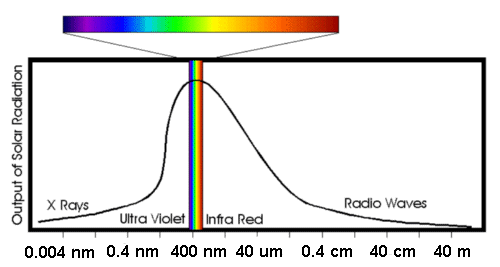 Solar Light DistributionWhen the light leaves the Sun, it traverse the nearly empty expanse through space until it reaches our atmosphere. There, sunlight encounters a much denser mixture of atoms and molecules of air with assorted dust particles suspended within it. A portion of the solar beam reflects right back into space off clouds and the larger suspended particles in the air. Other parts of the beam are absorbed and sent either re-radiated back to space or toward the surface, but a major portion continues its journey through the atmosphere toward the planetary surface. Through the AtmosphereDuring the split-second it takes for the solar beam to penetrate the atmosphere and reach our eyes, various atmospheric constituents have had enough time to affect the path of the incoming solar rays. Many are bumped off the direct path, scattered in the physicist's jargon, and, after many further bumps, continue their downward journey on a different angle from the original solar beam. This scattering is actually comprised of two different scattering processes. One called Rayleigh scattering is more effective at short wavelengths: the blue end of the visible spectrum. The other Mie scattering, which is not very wavelength dependent, produces the almost white coloration we see surrounding the sun. We find answers to our questions about sky color within the nature of this scattered portion of the solar beam. Scattering treats the wavelengths of the white light solar beam (which contains all the spectral colors) differently, and the effects depend on the size of the matter doing the scattering. Air atoms and molecules, being relatively small compared to the other particles in the atmosphere, scatter the shorter solar wavelengths, the violets and blues, more readily than the longer visible wavelengths, the yellows and reds. The scattering from molecules and very tiny particles (diameters< 1/10 the light's wavelength) is predominantly Rayleigh scattering. 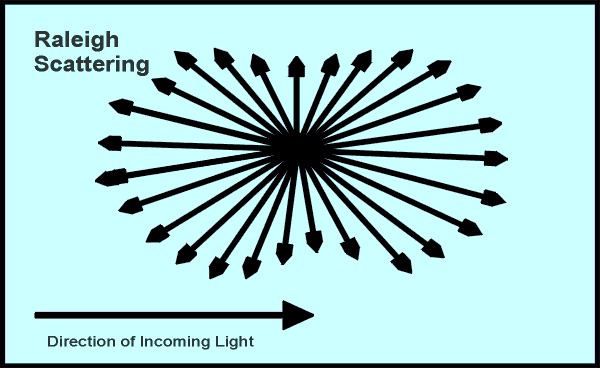 The scattered light rays scatter (hence the term) in all directions while a portion of the direct solar beam continues downward on it original course. As the scattered rays continue on, they are further scattered by other atmospheric constituents so that light rays reach our eyes coming from all directions away from the direct solar beam. These scattered wavelengths are called skylight which is richer in blue due to Rayleigh scattering as the angle away from the direct solar beam increases, separating it from the Mie-scattered portion. (Light reflected off clouds is also included in skylight.) 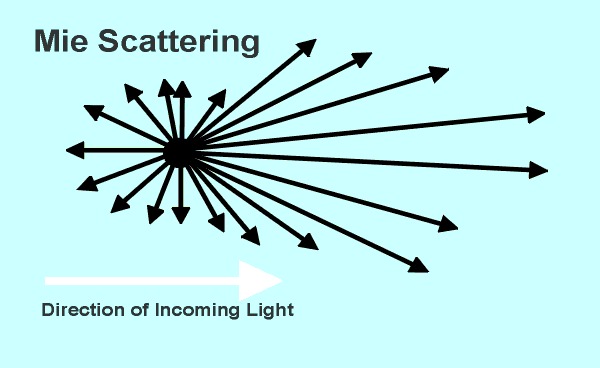 Meteorologists refer to the volume of atmosphere that solar light rays traverse as the optical air mass. In the cleanest, driest optical air mass, the scattered solar light is predominantly in the blue end of the visible spectrum, although it does contain some wavelengths of all colors. Rayleigh scattering due to air molecules scatters violet light about ten times more efficiently than red light, and blue about five times more efficiently, in the middle of the color's spectral band. As a result, we see an all-encompassing blue sky rather than the deep black sky seen by the Apollo astronauts on the airless Moon. The more air molecules lying between the observer and the incident solar beam, the thicker the optical air mass and, therefore, the greater the light scattering. As a result, the sky appears darker when we ascend a high mountain or fly to high altitudes in an aircraft than it is at the surface. This is because fewer air molecules are between us and the incoming solar beam at altitude to scatter the light around. The direct beam is also brighter at higher altitudes since less of its original brightness has been scattered or absorbed. 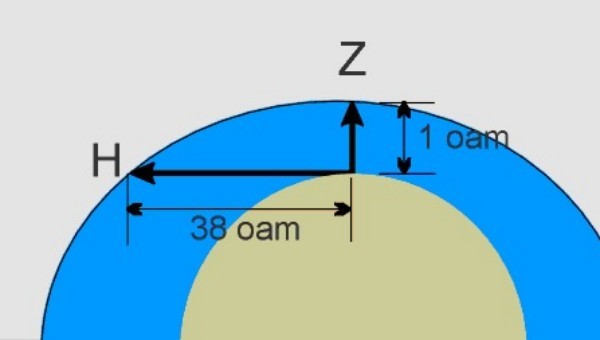 Optical air mass (oam) as measured from the zenith (Z) and the horizon (H). |
|||||||||||||||||||||
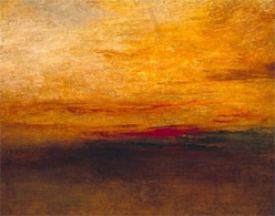 | 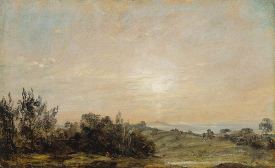 | 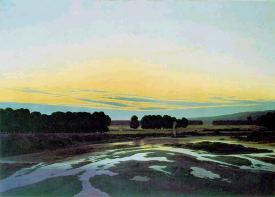 |
Sunset | Hampstead Heath | Largeness |
Though many great painters and paintings depicted realistic skies before the late-18th century, a full appreciation for the sky itself bloomed with the Romantic painters, notably J.M.W. Turner, John Constable and Caspar David Friedrich. All three were youths during a time when the eruptions of major volcanoes — Laki in Iceland and Asama in Japan in 1783 — altered sky color and increased optical phenomena for several years. These eruptions not only brought the sky to the attention of these future painters, but also had an impact on several major poets (Coleridge, Goethe). They were also active in 1815 when the great eruption of Tambora not only altered the visible nature of the sky but also produced the extremely cold summer of 1816 in many areas of the Northern Hemisphere. (This was also about the time that Howard's work was published for general distribution.)
Indeed, the colorful skies also influenced a young Luke Howard, who would take his fascination into the sciences. At the turn of the century, Howard would devise a system for naming the clouds that is almost unchanged today. His paper on the topic was translated into German and thus read by Johann Wolfgang von Goethe, a poet–philosopher– scientist, who was thoroughly impressed. He, in turn, commissioned Friedrich to do a series of cloud studies to illuminate Howard's naming scheme. Constable also set out to paint a watercolor cloud series. Turner turned his talents into depictions of sky-dominated scenes in a manner that would be called impressionistic or abstract today.
Turner's works brought the full admiration of John Ruskin who produced a five-volume set Modern Painter which Gedzelman noted: "This is the first work after Leonardo's Treatise on Painting to carefully inform painters what to look for when painting the sky." One chapter in Volume I was titled "On the Truth of Skies" another in Volume V, "On the Beauty of Skies."
John Constable, another of Howard's converts, wrote in his Lectures on Landscape Art that the sky is the "keynote, the standard of scale, and the chief organ of sentiment" for a landscape work. Constable's studies of sky have been important resources for both scientists and artists as he wrote detailed meteorological notes on the back of each painting of the conditions when the sketch was rendered.
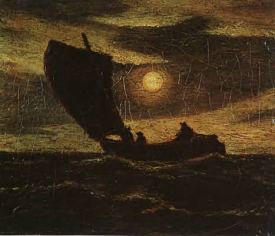 | 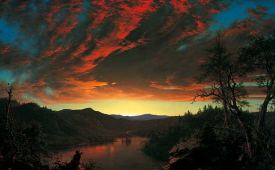 | 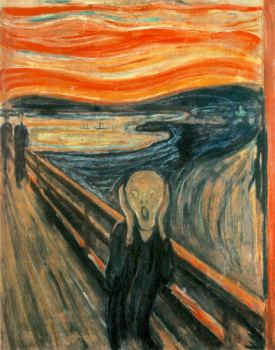 |
Toilers of the Sea | Twilight in the Wilderness | The Scream |
Constable's "organ of sentiment" could easily be an organ of emotion in an art work. We know that many striking paintings have been based on the mood engendered by the sky. "Toilers of the Sea" by Albert Pinkham Ryder and Frederic Church's "Twilight in the Wilderness" are two that come to mind, but likely the most famous is Edvard Munch's "The Scream" which he envisioned when enveloped in a blood-red sunset.
McKuen perhaps anticipate more that his initial question stated. In a later line in that poem, he asked "If you look beyond blue, what do you see?"
 |
To Purchase Notecard, |
Now Available! Order Today! | |
 |
 |
Now |
The BC Weather Book: |


